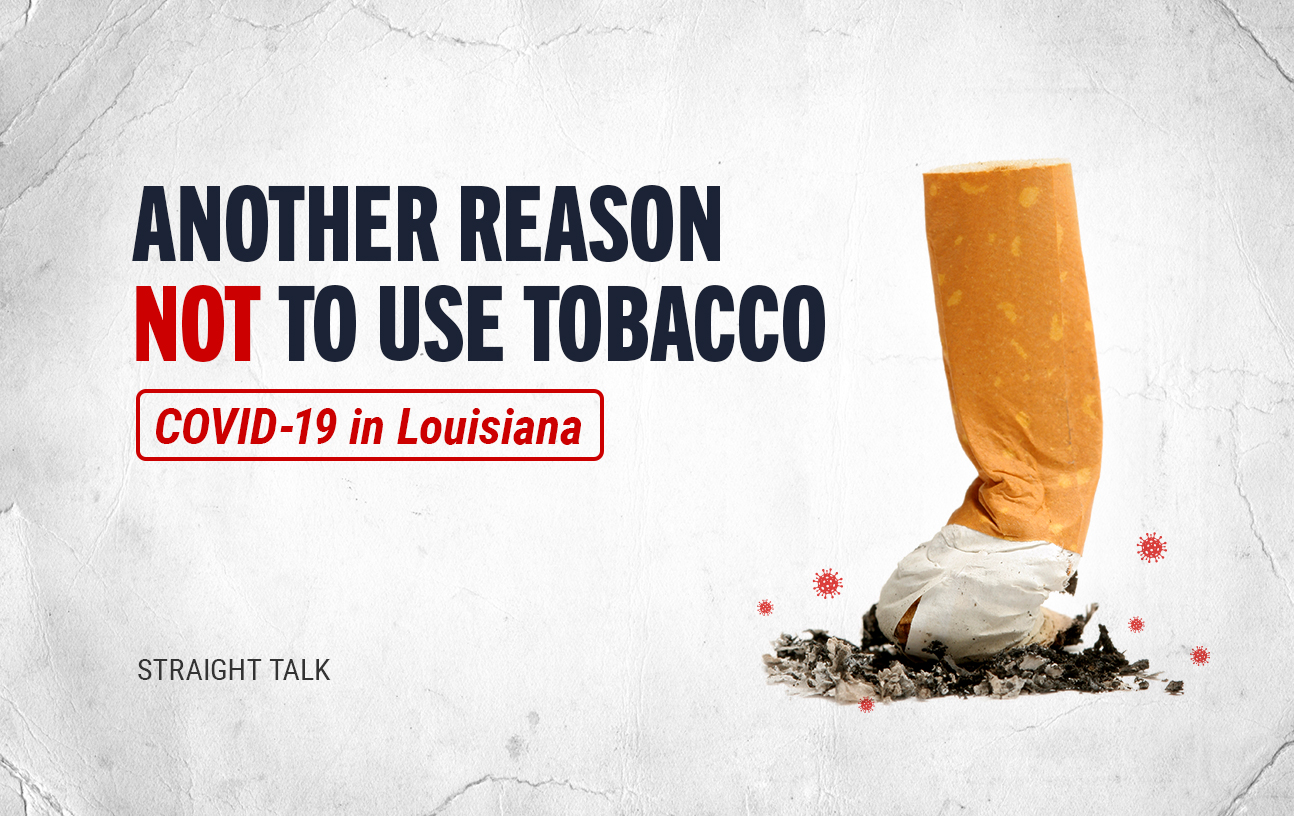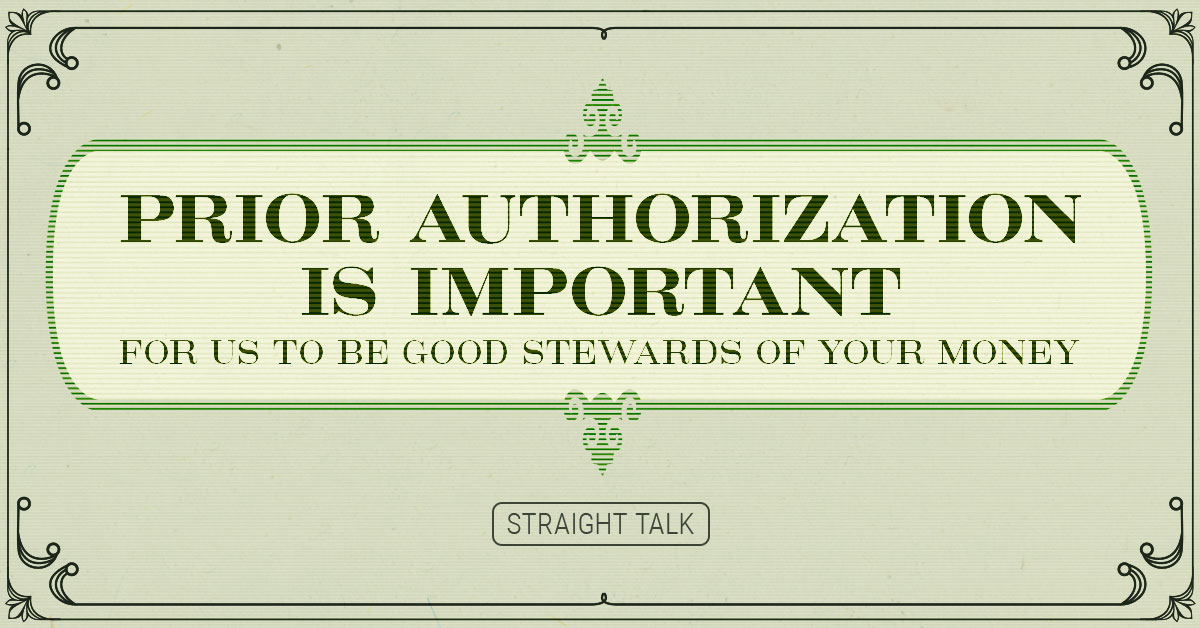It’s not that often I go after a specific, single behavior, but today I’m in a mood. And I just went through COVID-19, so I’m especially fired up.
Blessedly, my symptoms were not that severe, and I’ve recovered well. But while I was sick, I read a LOT about the impact of tobacco use on people trying to recover from COVID-19, and the news there is not good, especially for Louisiana. I’ve got several pre-existing conditions that could have made my bout with COVID-19 worse, but thankfully tobacco use is not one of them.
But for many Louisianians, that is not the case. I looked at the rates of tobacco use by state, and apparently, in Louisiana, our rates are VERY high.
According to the U.S. Centers for Disease Control and Prevention (CDC), 22.8% of Louisiana adults (age 18+) are daily tobacco users. Only three states have worse numbers than us. The CDC data is the most thorough I’ve ever seen, collecting surveys from dozens of sources, so you can take their numbers to the bank.
Even more frightening? One out of every eight high school kids is using tobacco every day. 1 out of 8.
Hang with me here – I’m going to start with my family’s story, tell you a little about the horrors nicotine carries out on your body and finish with how you can get help to quit smoking.
My Family’s Story
I grew up in a house with a lot of red flags. On one side of my family, people who drank too much alcohol and ruined lives. On the other side, people who smoked two or three packs a day of unfiltered cigarettes from an early age and died from cancer in their 40s.
I was blessed to have (and still have) a dad and mom who drew the line and said the family “curses” ended with them. I remember my dad still spending his life assuming that he would only live to age 48, even though he hasn’t touched a cigarette since he was 19. All because his dad died at that age of horrible lung and brain cancer.
Dad’s 82nd birthday, by the way, was March 26. Mom had hers in February. They both still run rings around me.
I have four siblings, and none of us smoke. The only one of us who had cancer was me (at age 22), and it was not lung cancer and not a smoking-related cancer. And, none of us have alcohol issues.
So, don’t believe in “family destiny.” You can make your own destiny by the way you live, eat, drink, sleep and work. Trust me on that one.
Straight Talk on Smoking
“So, Mike, we’ve been hearing all these warnings about smoking for years. What’s the big deal?”
I’m going to give it to you Straight, without scary pictures or crazy slogans.
When you ingest tobacco’s components into your bloodstream, whether through burning it or parking it next to your cheek and gums, lots of bad things happen to your body. Things that eventually cause irreversible damage. Every single time, although it can take longer or shorter in different people. That’s the trick, YOU CAN’T TELL. Until it happens, that is.
In addition, COVID-19 is primarily a respiratory ailment, meaning it attacks the lungs in nearly every patient. The inflammation caused by inhaled tobacco use simplified COVID-19’s task of damaging and destroying your lungs. Vaping, by the way, sets up the same simplified path for COVID-19 to do even more damage to your lungs.
Nicotine and Other Chemicals
First, you should understand that tobacco (the plant) contains a certain amount of nicotine. By the time that tobacco is processed and turned into something you can buy in the store, it contains thousands of chemicals that can damage your body. But the nicotine is what keeps you coming back for more.
Your body is a big fan of nicotine. It’s one of the most addictive substances known to humans. In fact, tobacco manufacturers, hoping to keep you hooked on their product, actually add chemicals to their products. Those chemicals force the cigarettes and snuff to release more nicotine and keep you wanting more. There is nothing “natural” about that.
One of those chemicals added is ammonia. Yum! Who doesn’t want a big hit of ammonia every day? If you use tobacco, it becomes a big determining factor for your overall health status. To choose to use tobacco is a lot like putting your most no-account relative in charge of your retirement fund.
Here’s another fun fact: If you are buying health insurance, and the people buying it with you (in your risk pool) use tobacco at the Louisiana rate (22.3%, per the CDC), you are paying 20-25% MORE for your health insurance because of the health conditions those tobacco users bring with them into the risk pool. Health insurers can charge tobacco users more, but they have to TELL US they use it for us to do that. Let’s just say that rate is under-reported. Reality is, we are ALL paying a lot more in healthcare costs to cover tobacco users.
Why is Tobacco Use so Bad?
I’ll move beyond “smoking is bad” and share with you some of the 50+ years of research on what tobacco does to your body as you ingest it. Here are some of my favorites, from Healthline and the CDC:
- High cholesterol—tobacco use increases your “bad” cholesterol and decreases your “good” cholesterol. Smokers and dippers are at a higher risk of clogged arteries and heart attacks at all ages. And, exercise does not offset any of the damage caused when you smoke.
- Weakened immune system—tobacco components in your bloodstream confuse and weaken your immune responses to viral and bacterial threats. So you won’t recover as quickly, or as fully, from COVID-19, the flu or any other infections. In fact, almost 90% of the people who get lung cancer are tobacco users. 90%.
- Insulin resistance—the fastest way to move from non-diabetic or pre-diabetic to full-blown diabetic is to throw tobacco into the mix. The chemicals make your body more resistant to the insulin you are producing, and this is a superhighway to Type 2 diabetes and lots of needles. Lots of needles.
- Smokeless tobacco—is no better than smoking and in some ways worse. Dip/chew contains even more nicotine than cigarettes. It is very harmful to your mouth, gums, teeth and throat. Snuff also contains a chemical often banned in food that causes colon cancer. That “pinch” will ruin your health just as fast as smoking does, and cancers in the mouth are almost impossible to contain.
- Female problems—women who smoke reach menopause at an earlier age, get hardened vocal chords (smoker’s voice), and yellow skin and nails. They get more wrinkles at an earlier age, more hot flashes, more cervical cancer, more blood clots, more trouble becoming pregnant and more heart attacks! Worth it?
- Spreading the effects—the particulate matter released when you smoke travels an average of 10 feet around you and is very persistent. It sticks to everything near you, including the lungs of your loved ones. If you already have COVID-19, your smoking behavior helps spread virus particles to the people around you. “Smoking outside” doesn’t help; the particulates stick to your clothes, hair and skin, and you give them to everyone you come near all day long, including your family.
- Death—On a day-to-day basis, a tobacco user, whether smoking or dipping, is three times more likely to suffer sudden, out-of-the-blue death than a non-tobacco user. Three times more likely to just drop dead. How about them odds?
In reality, tobacco use is driven by a variety of factors, but it all comes back to one thing: Chemical addiction enhanced by the manufacturer’s formula in the tobacco.
Using real, botanical tobacco is not good for you, but it is nowhere near as addictive as the snuff, chew or cigarettes you buy at the store, all of which have been manipulated and chemically enhanced to MAKE YOU WANT MORE. Encouraging you to lose control of yourself is the actual business model of these companies. Do you really want them to have more of your money?
Tobacco Use Isn’t Going Down
Recently, I saw something disturbing about tobacco use.
I’ve had a lot of “body work” (hip and leg surgeries) done over the years to recover from the damage cancer did to me in my 20s. I was forced to give up all my favorite sports like tennis and basketball and was left with… gulp! Golf.
After 30 years of playing (and still marveling when I break 90), I truly have found many things about the game to love. Really love. The history, the culture, being outside, the scenery and the satisfaction of a ball well struck are hard to replicate anywhere else.
But imagine my dismay when I noticed more and more young players using snuff or chewing tobacco on the course. They are out there. The TV does their best to filter it out, but the spitting and bulge in the cheek is unmistakable. Young athletes, inspiring others to pick up the game or maybe the snuff. This is the kind of battle we are fighting today against this habit and chemicals that seek to steal our lives. It is a battle worth fighting.
I realize it’s a lot easier to say smoking is bad than to kick the habit. Quitting is hard, dang hard. A good friend of mine quit last year, and he says he has dreams of smoking. He often wakes up thinking he’s “blown it” and is relieved to see that he was only smoking in his dreams.
You Can Get Help to Quit
It takes support, medication, a buddy and a determination to put your family and your life ahead of your addiction. That is never easy, but it can be done. Your brain LOVES nicotine, and it will fight to force you to feed it more. You have to fight those powerful urges, and you will need help.
And it’s worth it. Studies show that the benefits of quitting smoking start within minutes of smoking your last cigarette and increase dramatically over time.
There are tons of resources to help, starting with the Louisiana Tobacco Quitline. It’s a program through the Louisiana Department of Health where you can have free access to a quit coach who will work with you to develop a quit plan, a hotline to call when you need to be talked through cravings and/or get help to quit and lots of other resources. It’s funded publicly, so our members or anyone can use it.
We also cover quite a few smoking deterrent drugs Check the 2020 Covered Drug List (scroll down to page 90) to see which drugs are covered. Covered drugs differ slightly by plan type, so call the pharmacy number on your member ID card to see what drugs are covered on your plan.
Blue Cross members can reach out to our Care Management team. They can refer you to free programs to help you quit. If you have other health conditions like heart disease or asthma, you may qualify for free health coaching. Call 800-317-2299 to get started.
For your sake, for the sake of your family, for the sake of those around you, even for the sake of the next generation give it a go, will you?
Thanks for listening! Stay Straight with me!





Leave a Reply